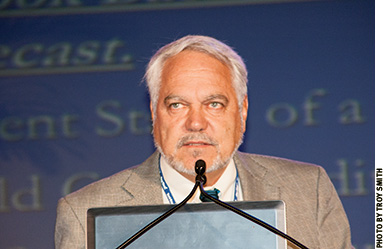La Niña Transition Maintains Drought
Creighton University's Art Douglas provides CattleFax weather outlook.
by Kasey Miller for Angus Journal
TAMPA, Fla. (Feb. 8, 2013) — The weather outlook for the spring and summer should be brighter for some this year, yet bleaker than last year for the Central Plains. Art Douglas, Creighton University, kicked off the CattleFax session Feb. 8 at the 2013 Cattle Industry Convention and National Cattlemen’s Beef Association (NCBA) Trade Show in Tampa, Fla.

Creighton University’s Art Douglas provided the CattleFax weather outlook.
The development of La Niña, though in transition, means that predictions are indecisive, but they likely favor continued drought in the center of the country, he said. The cold east Pacific and warm Atlantic favor widespread drought in the United States. These patterns are classic of La Niña. The cycles are likely to change in 2018 and 2024, he explained.
However, he predicted improved moisture in the Ohio Valley, Great Lakes and Northern Plains areas, which should help a portion of the Corn Belt. The pressure systems have been causing large storms on the East Coast, but moisture hasn’t ventured farther inland.
This winter was forecasted as being mild, though observed temperatures have been colder than originally thought. The spring should be dry for the Southeast, west Texas and much of the West Coast. It also will be warm, except in the Northwest and some moisture in the North. Some good news for the Corn Belt, he said normal moisture patterns and warm weather should encourage early planting.
Summer looks mild without big pressure systems in the Pacific, Douglas predicted. “It won’t be a repeat of the severe heat like last year.” Dryness will persist, though an above-normal hurricane season could bring more moisture in the late summer and early fall.
Globally, he said, India is in good condition, as is much of South America. Improved moisture should occur in Brazil and Argentina. Australia is facing incredibly dry conditions.
He explained that Arctic ice has been less lately, leading to much of the global warming discussion. However, he added, there has been recent recovery, as a result of the cycle of sped-up gulf-stream warming in the Atlantic. This is a cycle that lasts about 20-30 years, he said. What doesn’t reach the news is that Antarctic ice has increased significantly.
“There is no way you can have global warming … and have the Arctic get warm and the Antarctic get cold,” Douglas said. “Either the whole globe warms up or it doesn’t. What this really tells us is we’re looking at regional climate anomalies.”
--------------------
Editor’s Note: The above article was written under contract or by staff of the Angus Journal. It may not be reprinted without express permission of the Angus Journal. To request reprint permission, contact the editor at 816-383-5200.
www.4cattlemen.com is an event coverage site provided by the editorial team at Angus Productions Inc. (API), publisher of the Angus Journal, the Angus Beef Bulletin, the Angus Beef Bulletin EXTRA and the Angus e-List. For questions about this site, to submit an article for our consideration, or to report a broken link, contact the editor at 816-383-5200; 3201 Frederick Ave., Saint Joseph, MO 64506.
API claims copyright to this website as presented. We welcome educational venues and cattlemen to link to this site as a service to their audience.

